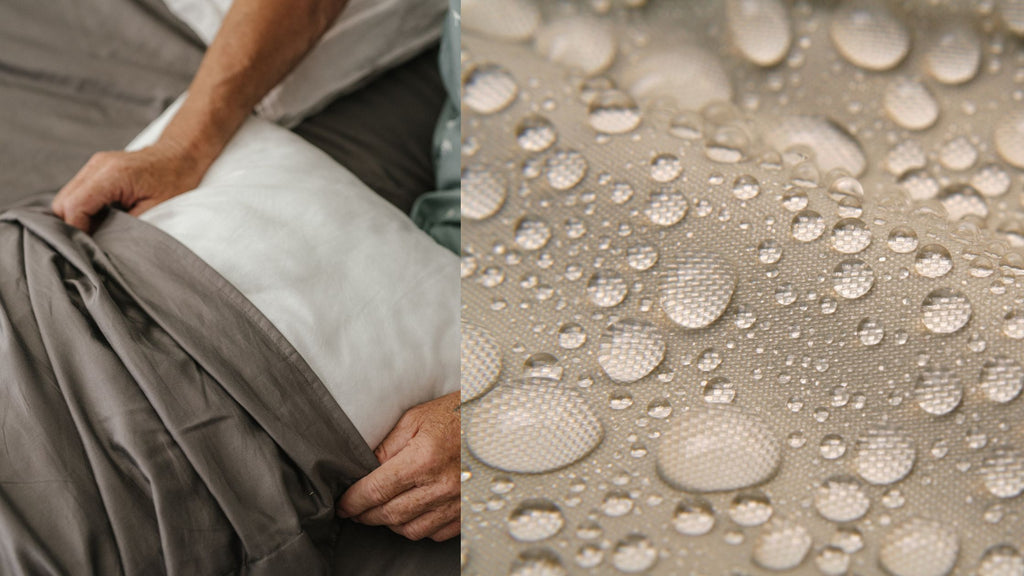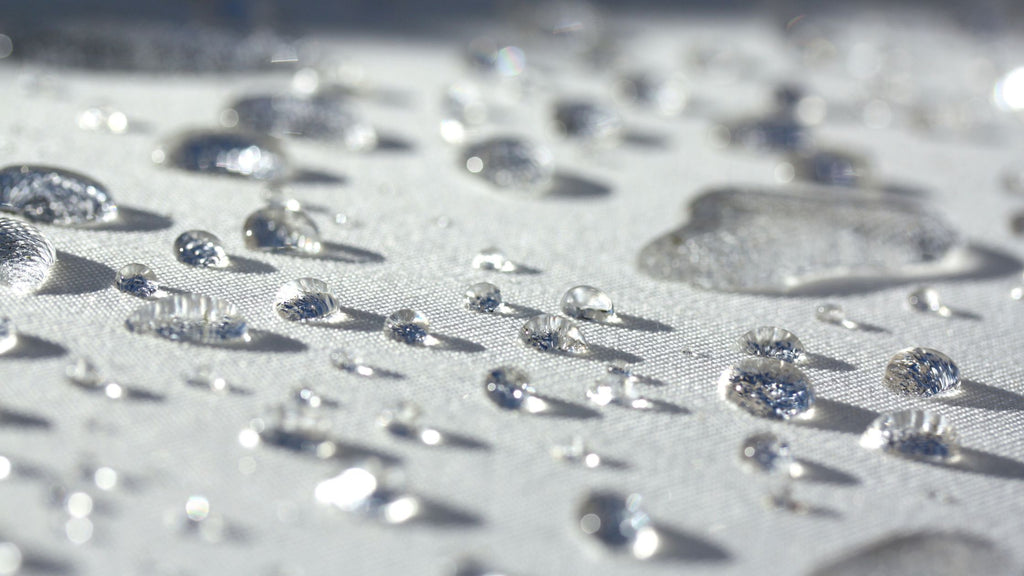In a world filled with countless bedding options, making informed choices is essential to enhance your sleep quality. One often overlooked aspect of this is choosing the right pillow cover. Have you ever wondered if there's a better way to safeguard your pillows while maintaining plush comfort? Or perhaps you’ve questioned whether investing in specialised pillow protection is worth it. These are valid concerns; we're here to provide you with the necessary answers. Specifically, we will discuss the differences between waterproofing pillow protectors and standard pillowcases and which one you should consider for a healthier and restful sleep.
Why Protecting Pillows is Essential?

Pillows are integral to our nightly comfort, providing the support necessary for a good night's sleep so pillowcase protectors are important. However, their importance often goes unnoticed until they're compromised.
Prolonged Pillow Lifespan
Pillow protection, whether waterproof pillow protectors or other options, can significantly extend their lifespan. By safeguarding against wear and tear, you can enjoy your pillows for years, saving you money in the long run.
Hygiene and Allergen Control
Pillows can accumulate dust mites, allergens, and even mould over time, triggering allergies or exacerbating respiratory issues, leading to discomfort and sleep disturbances. Proper pillow protection creates a barrier against these contaminants, ensuring a healthier and more hygienic sleep environment.
Stain Prevention
Standard pillowcases might offer some protection, but waterproof pillow protectors take it further because they protect against liquid damage, preventing stains and odours from permeating your pillows.
Temperature Regulation
Some pillow protectors are designed to regulate temperature, ensuring you stay comfortable throughout the night, which is particularly important if you tend to sleep hot or cold, as it can contribute to a more restful sleep experience.
Common Problems that Can Affect Pillows

Dust Mites
These microscopic pests thrive in the cosy environment of pillows, feeding on dead skin cells that can exacerbate allergies and asthma, leading to discomfort and sneezing during the night.
Allergens
Aside from dust mites, pillows can accumulate various allergens, including pet dander, pollen, and mould spores. Allergenic reactions to these substances can disrupt sleep and leave you feeling unrefreshed.
Moisture and Mould
Night sweats, spills, or high humidity can introduce moisture into your pillows. Over time, this moisture can foster the growth of mould and mildew, which not only damages the pillows but can also pose health risks.
Stains and Odours
Everyday occurrences like spills, makeup residue, or natural oils from your skin can lead to unsightly stains and unpleasant odours on your pillows that can impact the overall cleanliness and appeal of your bedding.
Loss of Support
Pillows gradually lose their shape and support over time, leading to discomfort and inadequate spinal alignment during sleep, resulting in neck pain, headaches, and disrupted sleep patterns.
Understanding Standard Pillowcases

Standard pillowcases are an essential bedding component designed to cover and protect pillows. These cases are typically rectangular and come in various sizes to accommodate standard-sized pillows, commonly used in bedrooms worldwide. Standard pillowcases are known for their versatility and are fundamental to creating an inviting and comfortable sleeping environment.
Unique Features and Benefits of Standard Pillowcases
Protection
Standard pillowcases serve as a protective barrier for your pillows as they shield them from dust, allergens, and direct contact with your skin, helping to maintain a cleaner and more hygienic sleep surface. While they offer some protection, specialised pillow protectors, such as waterproof or allergen-proof covers, may be less effective than they are.
Aesthetic Enhancement
Pillowcases come in various colours, patterns, and fabrics, allowing you to match them to your overall bedroom aesthetic. Pillowcases can be easily changed to update the look of your bedding or to celebrate different seasons and holidays.
Comfort
Standard pillowcases enhance your sleep comfort by providing a soft and smooth surface for your face to rest upon, contributing to a more pleasant sleep experience.
Easy Maintenance
Pillowcases are easy to remove and launder, making them a convenient choice for maintaining pillow hygiene. Regularly washing pillowcases helps to keep your sleep environment fresh and free from dust and allergens.
Materials Commonly Used in Standard Pillowcases

Cotton
Cotton is a popular choice for standard pillowcases due to its natural breathability, softness, and durability. It's hypoallergenic and suitable for year-round use, as it helps regulate temperature.
Satin
Satin pillowcases are known for their luxurious and smooth texture that makes it gentle on the skin and hair, reducing friction that can lead to hair breakage and facial wrinkles.
Linen
Linen pillowcases have a natural, textured look and feel. They are highly breathable and moisture-wicking, making them suitable for hot sleepers. Also, linen tends to become softer and more comfortable with each wash.
Silk
Silk pillowcases are prized for their exquisite softness and ability to minimise hair frizz and facial creases. They are gentle on the skin, can help regulate body temperature, and are often considered luxurious.
Microfibre
Microfibre pillowcases are known for their affordability and ease of maintenance. Microfibre pillowcases are also resistant to wrinkles and staining and are soft and smooth, making them a comfortable option.
Understanding Waterproofing Pillow Protectors

Waterproofing pillow protectors are specialised bedding accessories designed to provide a high level of protection for your pillows. These protectors are typically made from waterproof or water-resistant materials that create a barrier between your pillow and potential sources of moisture or liquids. Their primary purpose is to safeguard your pillows from spills, stains, and moisture damage, ensuring the longevity and hygiene of your pillows.
Unique Features and Benefits of Waterproofing Pillow Protectors
Waterproof or Water-Resistant
The standout feature of these protectors is their ability to repel liquids effectively. Whether spilt beverages, night sweats, or accidental spills, waterproofing pillow protectors are a reliable shield against moisture, preventing it from seeping into your pillows and causing damage.
Stain Prevention
By forming a waterproof barrier, these protectors prevent liquids from leaving unsightly stains on your pillows, which is particularly valuable for individuals who enjoy eating or drinking in bed or have young children or pets that may accidentally soil the bedding.
Allergen and Dust Mite Defense
Many waterproof pillow protectors are also designed to be hypoallergenic and resist dust mites, providing an added layer of protection against common allergens that can significantly benefit those with allergies or respiratory issues.
Easy Maintenance
Cleaning and maintaining waterproofing pillow protectors are straightforward tasks. Most can be machine-washed and dried, ensuring that your pillows remain fresh and free from mould or mildew growth.
Longevity
By preventing moisture damage and stains, these protectors extend the lifespan of your pillows, so you won't need to replace your pillows as frequently, saving you money in the long run.
Comfort Preservation
Modern waterproofing pillow protectors are designed to be comfortable and noiseless. They often feature soft, breathable fabrics that don't disrupt your sleep, ensuring you still enjoy a restful night's sleep.
Materials Commonly Used in Waterproofing Pillow Protectors

Polyurethane
This is a popular waterproofing material used in protectors because polyurethane protectors are often soft and noiseless, ensuring a comfortable sleep surface and it forms an effective waterproof barrier while remaining thin and breathable.
Vinyl
Vinyl is another waterproof material that provides excellent moisture protection. However, it can be less breathable and less comfortable than polyurethane options, and is often used in more budget-friendly protectors.
Microfibre
Some waterproofing pillow protectors feature a microfiber surface that is comfortable and soft to the touch. These protectors are often hypoallergenic and suitable for individuals with sensitive skin or allergies.
Cotton Blend
Some protectors combine cotton with a waterproof layer, offering a balance between comfort and moisture resistance, which can be a good choice if you prioritise natural materials.
Terry Cloth
Terry cloth protectors have a soft, absorbent surface like a towel. They are comfortable and offer moisture protection, making them a versatile option.
Pillowcases and Pillow Protectors: The Differences
Waterproofing Capabilities
| Pillowcases | Standard pillowcases typically lack waterproofing capabilities. They are designed primarily for aesthetics, comfort, and basic pillow protection but do not offer a reliable barrier against liquid spills or moisture. |
| Pillow Protectors | Pillow protectors, especially waterproof ones, are explicitly engineered to be water-resistant or waterproof. They create a barrier that effectively repels liquid, protecting the pillow from spills, stains, and moisture damage. |
Allergen and Dust Mite Protection
| Pillowcases | Standard pillowcases may offer some protection against allergens and dust mites, primarily by providing a physical barrier between your skin and the pillow. However, they are not explicitly designed to prevent these common allergens effectively. |
| Pillow Protectors | Pillow protectors, especially those labelled as allergen-proof, are designed with materials and construction methods that create an effective barrier against allergens and dust mites. They are particularly beneficial for individuals with allergies or asthma, as they can significantly reduce exposure to these triggers, promoting better sleep and overall health. |
Durability and Longevity
| Pillowcases | Standard pillowcases are generally less durable than pillow protectors and are often made for aesthetic purposes and comfort rather than long-term protection. However, frequent washing and use can lead to wear and tear over time. |
| Pillow Protectors | Pillow protectors are built with durability in mind because they are designed to withstand frequent washing and the rigours of protecting the pillow. As a result, they can extend the lifespan of your pillows and provide long-lasting protection. |
Conclusion
Choosing between waterproof pillow protectors and regular pillowcases is crucial for pillow hygiene and longevity. By understanding the differences and weighing your specific needs, you can ensure that your pillows remain clean, comfortable, and supportive. Whether you opt for the added defence of a protector or stick with the familiarity of a pillowcase, what truly matters is that you prioritise the protection of your sleep sanctuary. After all, investing in a well-protected pillow is a commitment to overall well-being.
Disclaimer: All the information, including the texts, images, and other materials on this website, is for educational purposes only. While we aim to provide accurate information, nothing on the Megafurniture website should be considered a replacement for medical advice, diagnosis, or treatment. Always consult a qualified medical professional before making any decisions regarding your health.








